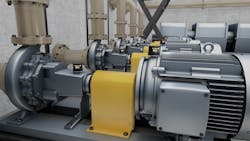Getting started with vibration sensors for asset condition monitoring
No maintenance team has an infinite budget or an unlimited staff. Managing the maintenance resources you do have is easier and more effective when you can plan and prioritize your efforts.
Monitoring the condition of your machines during operation gives you up-to-date information about their health and performance. Data related to vibration, temperature and more can be monitored and trended over time. With vibration sensors as part of a condition monitoring program, you will gain the insights you need to identify potential faults and determine which assets need attention — and when.
All rotating machinery has its own unique vibration signature. When a machine’s vibration pattern changes, that can be an indication of potential faults. And excessive vibration can cause premature wear in components and lead to shortened asset life. Vibration monitoring makes it possible to identify changes in vibration, enabling teams to diagnose faults early on and decide what steps to take. Taking action before failure occurs keeps machines running both better and longer.
Vibration sensor technology
Vibration sensors are one tool that can be used to track the condition of assets. When placed on machinery, vibration sensors can measure changes in the amplitude, frequency and intensity of forces that damage rotating equipment. Vibration sensors reduce the need for technicians to go asset to asset, taking measurements with handheld tools. Reducing route-based measurements and maintenance can also save time and increase worker safety. It is common in facilities today for assets to be located behind panels, up high or in other hard-to-access areas, so minimizing the number of trips technicians must take to hazardous or hard-to-access areas keeps them safer.
With the technology and connectivity available today, including cloud-based software, maintenance teams can conduct condition monitoring on machines from anywhere with an internet connection. Maintenance staff do not have to be standing at a machine to know how it is performing. Having real-time knowledge of asset condition means you can find and fix problems before they lead to costly failures or downtime.
There are a wide range of vibration sensors available on the market, making them an accessible option for teams and facilities of any size, type and budget. Wireless condition monitoring devices have been around for decades, but technological advancements have made them more affordable and accessible in recent years. For example, software advances have expanded sensor and data capabilities. And batteries are now smaller, longer lasting and less expensive than before.
Some sensors do not even have batteries at all — they rely instead on a concept called energy harvesting. These sensors essentially scavenge energy from their surroundings, using the vibration, heat or light from a machine to power themselves. They can operate without the limitations of batteries, which can run out and require replacement. Without batteries, sensors can also be made lighter and more compact. Their smaller size makes them a good choice for certain types of machines and settings, and also provides more flexibility in where they can be located on machinery.
Where and how a sensor is mounted also matters. And you may or may not want to mount a sensor permanently. Some alternatives to permanent mounting include magnets or adhesives. To be most effective, sensors should be mounted as near to the source of vibration as is feasible.
Wired and wireless vibration sensors
Vibration monitoring systems can include both wired and wireless vibration sensors. Asset criticality and accessibility are just two of the variables to consider when deciding on types of vibration sensors. These sensors are not a one-size-fits-all tool, and the needs of each asset should be considered on a case-by-case basis. Also keep in mind that a sensor is not needed on every asset, especially if you are just starting a vibration monitoring program.
Wired vibration sensors can measure and transmit constant vibration data, while wireless vibration sensors do so at regular intervals. This interval can vary depending on the sensor’s attributes and on the asset’s criticality and needs, but it can be as often as once a minute.
Wired vibration sensors are more expensive than wireless vibration sensors, in part because the installation process for wired sensors requires more materials and planning. Conduit and cables must be run, meaning more labor and materials costs. For some assets and settings, however, the cost of wired sensors is easily justified. Wired sensors can collect more extensive and detailed data than their wireless counterparts. Some assets require the more complete vibration picture that a wired sensor can provide. And with a wired sensor, data can be transmitted without considering the sensor’s battery life or bandwidth.
Wireless vibration sensors are simpler and cheaper to install than wired sensors, and they are ideal for use at scale. They are also ideal for settings where installing wired sensors is not feasible. Their data transfer speeds can depend on connectivity, location and other factors. Wireless vibration sensors make sense when an asset can be sufficiently monitored with snapshots of data, which limits the battery and the bandwidth used. They are typically most suitable for simple machines such as pumps, fans, compressors and blowers. Wireless sensors also make sense for hard-to-access places, and they are beneficial when you have limited labor resources.
Vibration data and analysis
Vibration analysis is the process of using a machine’s vibration data to identify faults. When any significant change in vibration is detected, vibration analysis determines the nature of the problem and what caused the change. Identifying and reading vibration patterns can require substantial training and experience. Teams without the headcount or budget to have someone trained in vibration analysis on staff full-time can look to consultants to conduct analysis on an as-needed basis.
There are also numerous analysis software options that can be paired with sensors to offer answers and insights. Some combination of sensors, software and in-house or outside vibration experts can ensure that you get the most out of your vibration monitoring setup — and your assets.
Intensive, detailed vibration data gathering can require a lot of energy. Not every vibration sensor available can do an FFT (Fast Fourier Transform), for example. For some assets, high-frequency spectral data is important. The type of data an asset requires in order to be monitored effectively determines the size and energy needs of the sensor it should have. Some assets may be sufficiently covered by battery-less sensors that scavenge energy. These types of vibration sensors are mainly geared toward performing screenings to determine whether or not an asset is operating normally. But in some instances, an overall vibration snapshot is not enough data. Larger, more robust sensors can take full spectral data up to several times per day.
Vibration data, once collected, can also be trended over time. This provides insights about your operations and makes it possible to optimize maintenance decisions and actions. Remember, though, that more data is not automatically better. Data you do not have a plan for just becomes noise and gets ignored. Select sensors based on what is needed for your assets, rather than assuming that collecting detailed vibration data from every asset is the most effective route. If your team becomes bogged down with data, the data is a nuisance and not a benefit. And if your team learns to tune out data, no program will be effective.
The vibration data you collect should be able to give you the answers to a few key questions:
- Is there a fault?
- What is the fault?
- How severe is the fault?
- How and when should we fix it?
Ultimately, vibration monitoring should provide the information you need to plan maintenance actions. From staffing to inventory to the timing of repairs, vibration data can help you plan thoroughly in advance rather than reacting to failures.
Vibration sensors can enhance maintenance and reliability programs by detecting problems that lead to safety issues, premature wear or shortened asset life. By trending the data sensors collect over time, you can gain insights into asset health and tailor maintenance actions to maximize asset uptime and prevent unplanned downtime. Vibration monitoring can be paired with other tools and methods — for example, oil analysis, thermography and power monitoring — as part of a complete condition monitoring program.
As a mechanical application and product specialist with Fluke Reliability, John Bernet works with customers from all industries to successfully implement their reliability programs. He has more than 30 years of experience in the maintenance and operation of commercial machinery and as a nuclear power plant electrician in the U.S. Navy. He holds a Category II Vibration Analyst certification and is a Certified Maintenance Reliability Professional (CMRP).
Fluke



